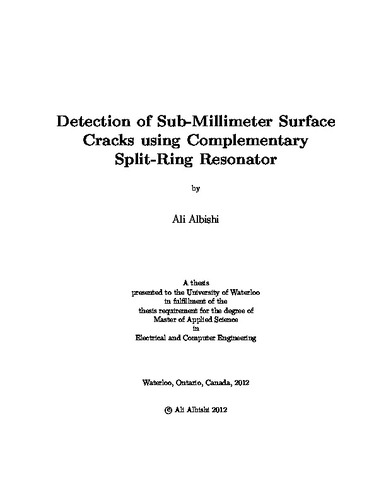| dc.description.abstract | Many interesting ideas have emerged from research on electromagnetic eld interactions
with di erent materials. Analyzing such interactions has extracted some essential proper-
ties of the materials. For example, extracting constitutive parameters such as permittivity,
permeability, and conductivity, clari es a material's behavior. In general, the electromag-
netic eld interacts with materials either in the far- eld or near- eld of a source. This
study focuses on the principle of near- eld microwave microscopy for detection purposes.
Many studies have focused on the use of an electrically small resonator, such as a
split-ring resonator (SRR) and a complementary split-ring resonator (CSRR), to act as a
near- eld sensor for material characterization and detection. At the resonance frequency,
the electric and magnetic energy densities are enhanced dramatically at certain locations
in the resonator. Any disturbance of the eld around such a resonator with a material
under test causes the resonance frequencies to exhibit a shift that is used as an indicator
of the sensor sensitivity. In this thesis, a single CSRR is used as a sensing element for
detecting cracks in metal surfaces.
Many microwave techniques have been developed for crack detection. However, these
techniques have at least one of the following drawbacks: working at high frequencies,
measurement setup complexity and cost, and low sensitivity. The rst part of this thesis
presents a new sensor based on the complementary split-ring resonator (CSRR) that is used
to detect sub-millimeter surface cracks. The sensing mechanism is based on perturbing the
electromagnetic eld around an electrically small resonator, thus initiating a shift in the
resonance frequency. Investigation of the current distribution on a CSRR at the resonance
frequency shows the critical location at which the enhanced energy is concentrated. In
addition, the current distribution demonstrates the sensing element in the CSRR. The
sensor is simple to fabricate and inexpensive, as it is etched-out in the ground plane of
a microstrip-line using printed circuit board technology. The microstrip-line excites the
CSRR by producing an electric eld perpendicular to the surface of the CSRR. The sensor
exhibits a frequency shift of more than 240 MHz for a 200 m crack.
In the second part of this thesis, the sensitivity of the sensor is increased by lling
the same crack with a dielectric material such as silicon oil. While using CSRR to scan a
block with 200 m wide and 2 mm depth dielectric lled crack, the resonance frequency
of the sensor shifts 435 MHz more than a case scanning a solid aluminum. Finally, the
total Inductance of a CSRR for miniaturizing purposes is increased using either lumped or
distributed elements. In this thesis, the designs and the results are validated experimentally
and numerically. | en |

